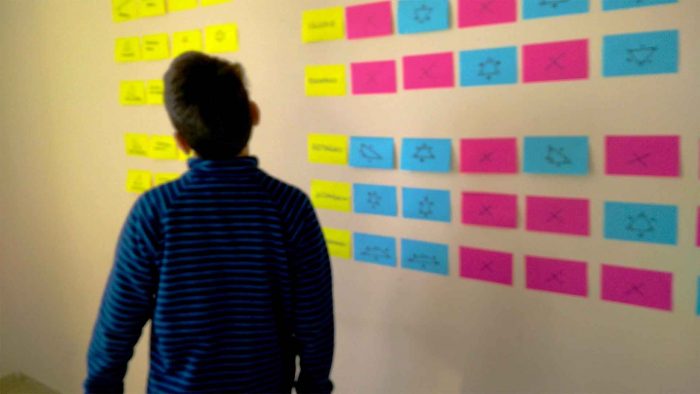I designed a learning game with a group of young lads who needed to study the geometry of triangles. Funny constraints helped to keep the interest high and visual facilitation improved understanding of how knowledge is structured in the field of geometry.
The Rules Of The Learning Game
We started by listing all types of triangles:
- Scalene
- Isosceles
- Equilateral
- Rectangle
- Acute-angle
- Obtuse-angle
I’ve prepared plenty of post-it notes and markers of different colors. The first column was about listing names. The second column was “Definition”. Participants, using only one post-it, wrote a very short definition of the item on the left.
| TRIANGLE | DEFINITION |
| Scalene | Has all different sides |
| Isosceles | Has two equal sides |
| Equilateral | Has all sides equals |
| Rectangle | Has one right angle, and two acute |
| Acute-angle | Has all acute angles |
| Obtuse-angle | Has one obtuse angle |
Things started to become too abstract and a bit boring. I invented a game: what if you have to explain those definitions to an Alien who doesn’t understand your language?
This was stimulating in finding a visual way to explain the characteristics of each triangle without using words.

It became obvious that we needed to find a code to communicate the nature of each side and each angle. Participants, smartly, suggested using color. So I added another column where, if you don’t want to be “invaded”, you have to convince a deaf and color-blind alien about the right description for each geometrical shape.
In this case, learners cannot use colors so they are forced to create symbols to show similar and different features.
An interesting application is to highlight each side and repeat their shape near the main figure by comparing their lengths.
Example:

In the next activity, we wanted to build a table where we cross types of triangles, a truth-table in which we wanted to answer questions like “Can you build a Scalene-Equilateral triangle?”
That is where beauty emerged. Look at that:

And after a quite long working session, during which I struggled to keep the attention and the concentration of learners we finally got an overview of all possible couple-combinations of triangle types.
Good choices
Different colors for heading rows and columns (yellow), valid combinations (light blue) and impossible combinations (purple).
Improvable choices
Using rectangular-shaped post-its. It would have been better to use squares because it would have enhanced the symmetry which emerged from this table.
And finally: the symmetry!
Can you see the diagonal symmetry in the table? This is a peculiar characteristic of this type of truth-tables. And it’s also a property that you can use to check results. In the previous figure. If you check carefully there’s not perfect symmetry. This helped me, at first, unfortunately not the learners, to spot an error.
Compare the previous table with the fixed one to see the difference:

Symmetry helped to check the rightness of the results and, if you recognize this pattern, it would help you in saving time: you could fill in only one-half of the cells, the other half is specular. Moreover, the diagonal where there are combinations between the same items you don’t have to think particularly hard: an equilateral-equilateral triangle is just… an equilateral triangle.
And if you really could not spot the difference between the two versions of the truth table, here is the solution:

Pros and Cons of Using Symmetry as a Learning Method
This simple and straightforward thinking tool has the following features:
- Visualizes geometrical shapes
- Compares geometrical features visually
- Combines and contrasts different types into combinations, highlighting: identities, differences, similarities.
- Makes use of color-coding to highlight notable characteristics
- Makes use of space: bi-dimensional data visualization
- Promotes pattern recognition: symmetry and specular repetition
- Makes fun use of constraints (deaf and color blind aliens forcing to use symbols and colors instead of words). Learning as a game
Disadvantages and critical areas:
- Attention demanding: for a young pupil, it could take too long to build the two tables. If needed, split the activity into two sessions.
- Comfortable room required: you need to have a large wall to hang the tables.
- Material preparation: be prepared with lots of post-its, at least 3 different colors and shapes, and 3 different colors of felt-tip markers.
- Growth-mindset is a must: allow participants to make a lot of errors without any hesitation nor punishment. Just throw away the post-its not deemed to be adequate or not clear enough.
- Adaptability and lean thinking: suggest participants to improve any post-it as soon as they perceive there is something wrong. Just replace the old ones with newly written ones. There should be a continuous refinement of the solution without thinking too much.
- Embody and act: role-play the “aliens”: “I am deaf, I cannot read”, “Uhm this is not really clear to me, I cannot see a triangle here”. And so on.

